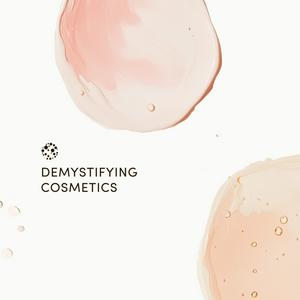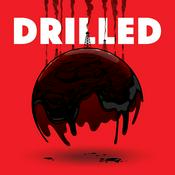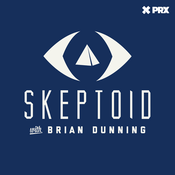Available Episodes
5 of 30
- Framing the Formula: How Visual Storytelling Shapes Cosmetic BrandsWhat do your products look like to the world? Beyond INCI lists and claims, beauty brands are built—visually. In this episode of Demystifying Cosmetics, Jennifer Cookson is joined by Anderson, the creative mind behind A-Son Agency and By-Anderson, whose photography brings brand philosophies to life. We explore how product photography, creative direction, and brand identity intersect to tell a cohesive visual story. Whether you’re a founder, marketer, or formulator, this episode will make you think differently about the images you use to represent your work.Takeaways:• Social-First Strategy Delivers More Value for Indie Brands: Rather than spending a million dollars on a campaign and tacking on behind-the-scenes content for social as an afterthought, emerging brands should build from social up. Most sales for small brands come from social media and world-building on platforms, so investing in volume of nimble, repurposable content often outperforms one expensive hero campaign.• Authentic Representation Requires Intentional Casting and Self-Awareness: Brands don't need to check every diversity box—they need to authentically know their consumer and represent them well. Hiring a casting director who understands your specific audience, studying brands doing representation well (like MAC's VivaGlam or Fenty's shade inclusivity), and ensuring consumers see themselves in your imagery creates genuine connection rather than performative gestures.• Visual Storytelling Translates Technical Into Emotional: Communicating formulation sophistication for products that all look like white cream requires strategic choices in lighting, color palette, context, and where assets live. An SPF might use warmer, sunnier lighting within the same setup as other skincare products, while the combination of imagery, copy, and display context tells the complete story.• Budget Constraints Demand Smart Collaboration and Relationships: Working with limited budgets (realistically $10,000+ for quality results) requires finding photographers whose vision aligns with your brand rather than chasing big names. The creative industry runs on personal relationships where artists often offer favorable rates for brands they believe in, knowing the work will benefit their portfolio and lead to future opportunities.• Test Brand Recognition by Removing Product from Imagery: A strong visual brand identity means you'd recognize a Crème de la Mer ad even with the product covered. This test helps brands evaluate whether their visual language—lighting, color, mood, casting—truly communicates their brand DNA consistently across all assets rather than just relying on the product itself.Find Anderson's photography work and get in touch through:Linkedin: https://www.linkedin.com/in/byandersonx/Website: https://by-anderson.com/Agency website: https://www.a-son.agency/--------28:16
- Biotech Beauty: Hype, Hope, or Greenwashed Science?The beauty industry is buzzing with terms like “lab-grown,” “bioengineered,” and “nature-identical”—but what do these really mean, and how much of it is science versus storytelling? In this episode of Demystifying Cosmetics, we’re joined by David Breslauer, a synthetic biologist and the co-founder and CTO of Bolt Threads, a pioneering biomaterials company known for innovations like lab-grown spider silk and mycelium-based leather.David brings deep expertise in synthetic biology and materials science—and a refreshingly grounded take on how biotechnology is being positioned in beauty and fashion. We explore what’s real, what’s overstated, and what it takes to move from breakthrough to brand adoption without falling into the greenwashing trap.From ingredient sourcing to consumer trust, this conversation peels back the layers of innovation to reveal what biotech can actually deliver—and what still needs to evolve.Takeaways:• Biotech Means Engineering Living Systems, Not Just Natural Extracts: True biotech involves engineering microbes, plant cells, or enzymes to manufacture molecules or materials unavailable or unaffordable from nature at industrial scale. Standard plant extracts, purified crop ingredients, or cold-pressed botanicals being rebranded as "biotech" dilute the term's meaning, even though they may be valuable ingredients in their own right.• The Path to Market Is Longer and More Expensive Than Most Realize: Taking a biotech ingredient from proof of concept to market-ready requires 5-10 years and $10-150 million before reaching breakeven volumes. This includes years of lab R&D, clinical trials for efficacy claims, pilot scale manufacturing, downstream purification, quality control, and three years alone just for global regulatory approval.• Scale-Up and Cost Effectiveness Are the Highest Risk Points: While scientific discovery is challenging, the compounded risk comes after finding a functional molecule. The highest failure rate occurs when trying to achieve cost-effective, routine manufacturing at scale. Many promising ingredients die because they're stuck in non-scalable discovery systems, can't secure investment for scale-up, or never achieve competitive pricing.• Independent Brands Are Essential First Movers: Big CPG brands require extremely compelling reasons (10,000x better performance) to switch global supply chains. Independent beauty brands willing to pay more and take risks serve as crucial first movers, helping biotech companies navigate regulatory filings, build supply chain diversity, and prove market viability before transitioning to larger customers.• GMO Attitudes Are Shifting, But Education Remains Critical: The majority of brands have moved past GMO concerns, especially with certifications like "from GMO, but not GMO" that clarify the ingredient itself contains no genetic modification. However, a few large CPG players are still figuring out their policies as they risk being left behind when the next billion-dollar brand is built on recombinant ingredients like growth factors.--------42:39
- Finding Your Voice: Whitespace, Words & What Makes a Beauty Brand StickWhat makes a beauty brand truly memorable? In this 40-minute episode, verbal identity strategist Taylor de Diego shares how she helps brands uncover their whitespace and build a voice that’s unmistakably theirs.Taylor shares her journey from working at L'Oréal and MAC Cosmetics to launching her own company after experiencing firsthand the frustration of finding the right foundation shade.The conversation explores how AI and computer vision are transforming the beauty industry, the challenges of building accurate shade-matching technology that works across diverse skin tones, and the complex relationship between online and in-store beauty shopping. Taylor discusses the technical hurdles of training AI models with limited diverse data, why personalization in beauty goes far beyond just matching your skin tone, and her vision for using technology to make beauty more accessible and inclusive while maintaining the joy and discovery that makes cosmetics shopping special.Takeaways:• AI Shade Matching Requires Diverse, Quality Training Data: Building accurate shade-matching technology is challenging because historical beauty datasets lack diversity in skin tones and undertones. Training AI models requires extensive data collection across different lighting conditions, skin types, and product formulations, with particular attention to ensuring accuracy for deeper skin tones that have been historically underserved by the beauty industry.• True Personalization Goes Beyond Skin Tone: Effective beauty recommendations require understanding multiple factors including skin type, concerns, preferences, budget, and values like clean beauty or sustainability. Just matching foundation shade isn't enough - the technology must consider finish preferences, coverage needs, ingredient sensitivities, and even shopping behaviors to create truly personalized experiences.• Online Beauty Shopping Presents Unique Challenges: The biggest barrier to online cosmetics purchasing is confidence in shade matching and product suitability. While technology can help bridge this gap, the sensory experience of testing textures, seeing shimmer, and discovering products in-store remains valuable. The future likely involves hybrid experiences that combine digital convenience with tactile discovery.• Computer Vision Technology Must Adapt to Real-World Conditions: Developing shade-matching technology that works accurately across different lighting conditions, phone cameras, and environments is extremely complex. Variables like natural versus artificial light, camera quality, and even how users position their phones all impact accuracy, requiring sophisticated algorithms that can normalize and adjust for these factors.• Building for Inclusion Requires Intentional Design from Day One: Creating technology that works equitably for all skin tones can't be an afterthought. It requires intentionally seeking out diverse perspectives, testing extensively with underrepresented groups, and making conscious decisions about data collection and algorithm training that prioritize accuracy across the full spectrum of skin tones rather than optimizing for the majority.--------42:01
- Fragrance with Purpose: Building Sustainable Scent Strategies with Cassandra BrowningFragrance has the power to spark memories, define brands, and create lasting emotional connections—but how can it also do good? In this 30-minute conversation, Cassandra Browning, founder of Fragrances for Good, shares her vision for a more conscious and innovative fragrance industry.With a degree in aroma and formulation science from the UK and experience spanning global fragrance houses including L'Oréal and as EU fragrance head for Ecover and Method, Cassandra brings rare expertise bridging creative and technical aspects of fragrance.Takeaways:Context Makes a Fragrance Brief Effective: A good fragrance brief goes far beyond describing how something should smell. Include target demographic, brand positioning goals, whether you're trying to disrupt or align with category norms, and how the launch fits your overall brand strategy. This context allows fragrance houses to make strategic recommendations, like suggesting vanilla over apple for disrupting a 50-year-old woman's dishwashing habits.No Universal Standards for Fragrance Sustainability: Each fragrance contains at least 30 ingredients, each with its own complex supply chain, making sustainability assessment extremely difficult. Fragrance houses are creating internal scorecards measuring renewability and naturality, but metrics like water use, land impact, and carbon footprint are nearly impossible to standardize. Even getting competing fragrance houses to agree on basic definitions is extraordinarily challenging.Natural Doesn't Equal Sustainable or Safe: The assumption that natural ingredients are automatically better is flawed. It takes 10,000 pounds of rose petals to make one pound of rose oil, creating massive water, land, and energy impacts. Natural ingredients also contain more allergens. Meanwhile, some eco-labels like Nordic Swan advocate for 100% synthetic ingredients as better for skin and environment, while others like Ecosurf require 100% essential oils.Build Olfactory Brand Identity Before Individual Products: Successful multi-category brands establish a clear fragrance strategy defining what their brand stands for olfactively, like "fragrances found in nature" or specific adjectives and performance levels. This framework then guides all product development across categories, ensuring consistency while meeting individual category norms, rather than treating each fragrance as a standalone decision.Innovation Requires Balancing Disruption with Consumer Comfort: In established categories like toothpaste or laundry where consumers associate specific scents with efficacy (mint equals clean teeth, certain notes equal clean laundry), innovation must find ways to differentiate through ingredient stories, sourcing narratives, or technical approaches while maintaining the non-negotiable comfort signals consumers expect.Connect with Cassandra and learn more about strategic fragrance development at: https://www.fragrancesforgood.com/--------37:56
- More Than a Molecule: What It Really Takes to Launch a New Cosmetic Ingredient with James DillardIn this candid 30-minute conversation, James Dillard shares what he wishes he had known before launching a new cosmetic ingredient—and what every formulator, brand founder, and raw material supplier should understand about the realities of innovation in beauty. We explore: Why scientific elegance isn’t enough—and what actually moves decision-makers, the invisible gatekeepers that stall ingredient adoption, how messaging, not just molecule design, shapes commercial success, why the industry’s narrow lens can block cross-industry innovation and the importance of storytelling, positioning, and relentless clarity.Takeaways:• The Unconventional Entry Point: James entered cosmetics through kelp as a zero-input crop, choosing beauty over nutraceuticals due to small-scale manufacturing requirements and high-value products. The beauty industry operates as a warm, tight-knit community that takes care of its own once you earn trust.• Scientific Elegance Isn't Enough: Ingredient developers must translate technical performance into consumer benefits. Buyers want uniqueness that creates lasting customer relationships, not just novel chemistry. Understanding that "unique" might mean a plant-based pump spray mineral sunscreen, not impressive lab results.• Focus on One Use Case, Not Everything: Claiming your ingredient works for everything reads as "good for nothing." Focus on being 10 out of 10 in one specific application to overcome the risk hurdle. Customers will naturally experiment with other uses over time and feed back into your innovation loop.• Expect Long Sales Cycles and Build Trust Slowly: Plan for 12-18 month sales cycles with the first six months just building trust. The industry won't trust you until they see you at conferences twice. This creates challenges for startups needing to show investors concrete commitments beyond handshake deals.• Contract Manufacturers Can Enable Innovation: CMs are uniquely positioned to offer conditional contracts to ingredient startups, solving the chicken-and-egg problem of scaling. This would allow startups to show investor traction while giving CMs exclusive access to novel ingredients that differentiate their offerings.Whether you're a startup trying to break into the ingredient space or a brand overwhelmed by the influx of “next-gen” actives, this episode offers an unfiltered look at the grind behind the gloss.--------41:15
More Science podcasts
Trending Science podcasts
About The Demystifying Cosmetics Podcast
The Demystifying Cosmetics podcast, hosted by industry veteran and beauty enthusiast Jennifer Cookson, creates a space for open and insightful conversations about the ever-evolving cosmetics world. At Tagra, we connect chemists, formulators, product developers, and marketers to discuss the latest trends, innovations, and strategies shaping the future of beauty. Join us as we break down technical barriers and uncover the stories and insights driving the next generation of cosmetics.
Podcast websiteListen to The Demystifying Cosmetics Podcast, Science Weekly and many other podcasts from around the world with the radio.net app

Get the free radio.net app
- Stations and podcasts to bookmark
- Stream via Wi-Fi or Bluetooth
- Supports Carplay & Android Auto
- Many other app features
Get the free radio.net app
- Stations and podcasts to bookmark
- Stream via Wi-Fi or Bluetooth
- Supports Carplay & Android Auto
- Many other app features


The Demystifying Cosmetics Podcast
Scan code,
download the app,
start listening.
download the app,
start listening.




















![Podcast Cosmosis [Formerly The UFO Rabbit Hole]](https://nz.radio.net/podcast-images/175/the-ufo-rabbit-hole-podcast.jpeg?version=c4cfeed14331265219e0263fd62be755644a8cf4)
















